NCERT Solutions for Class 12 Maths Chapter 13 - Probability - Exercise 13.2
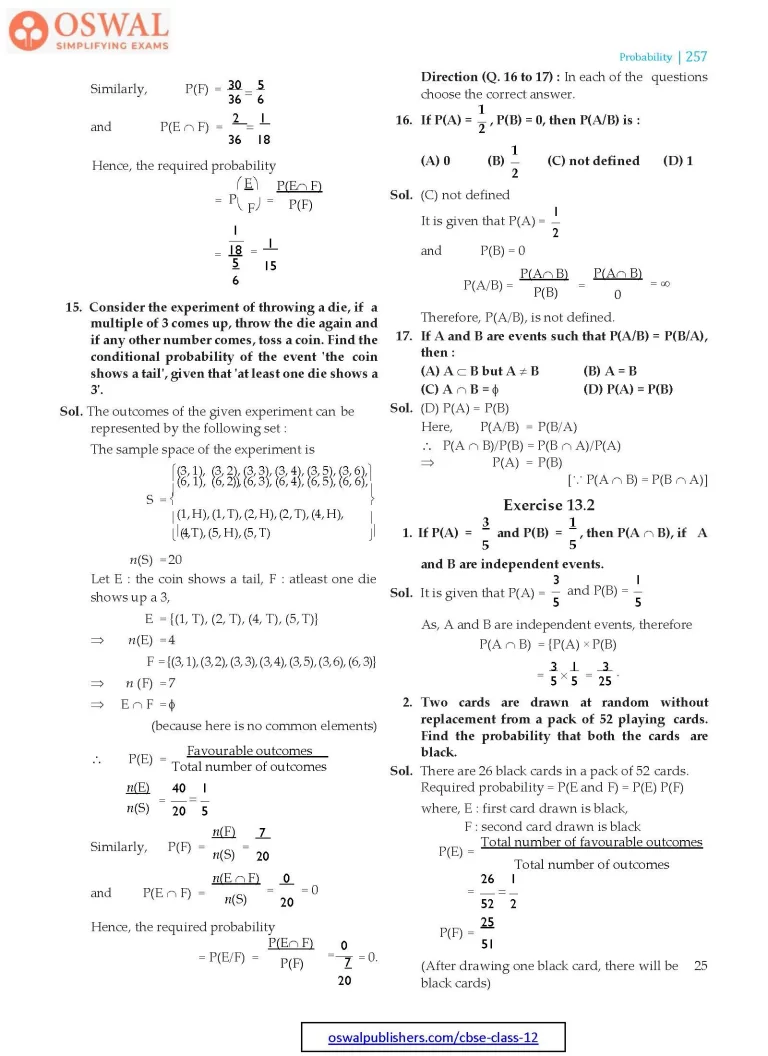

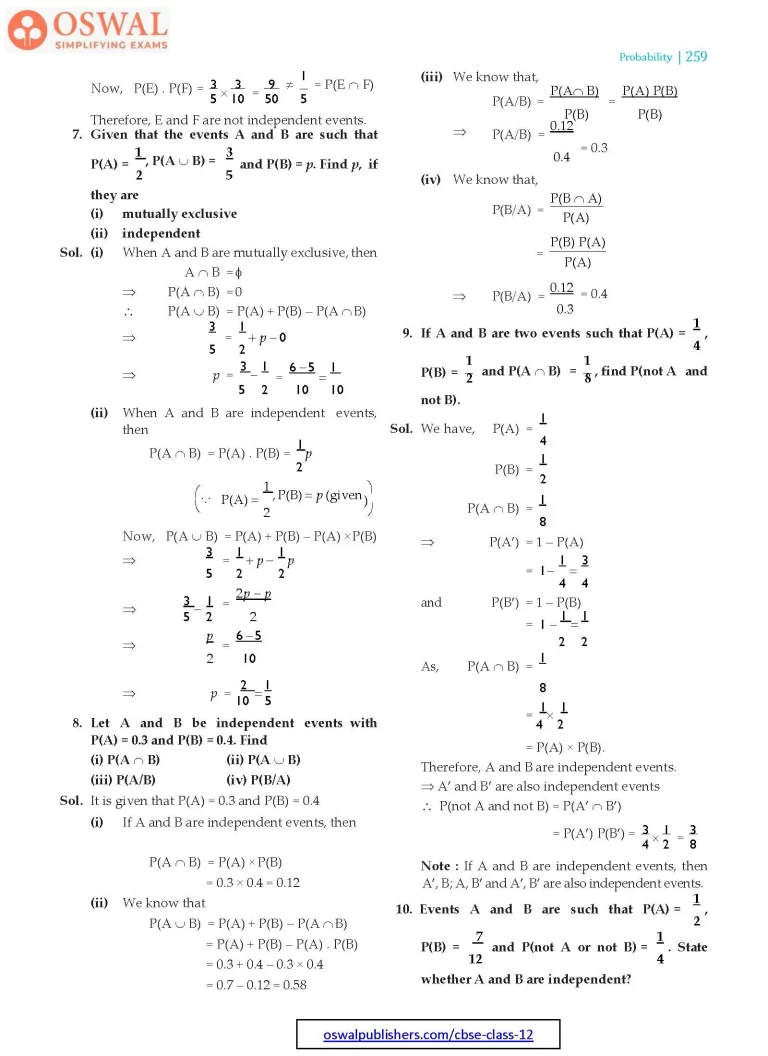
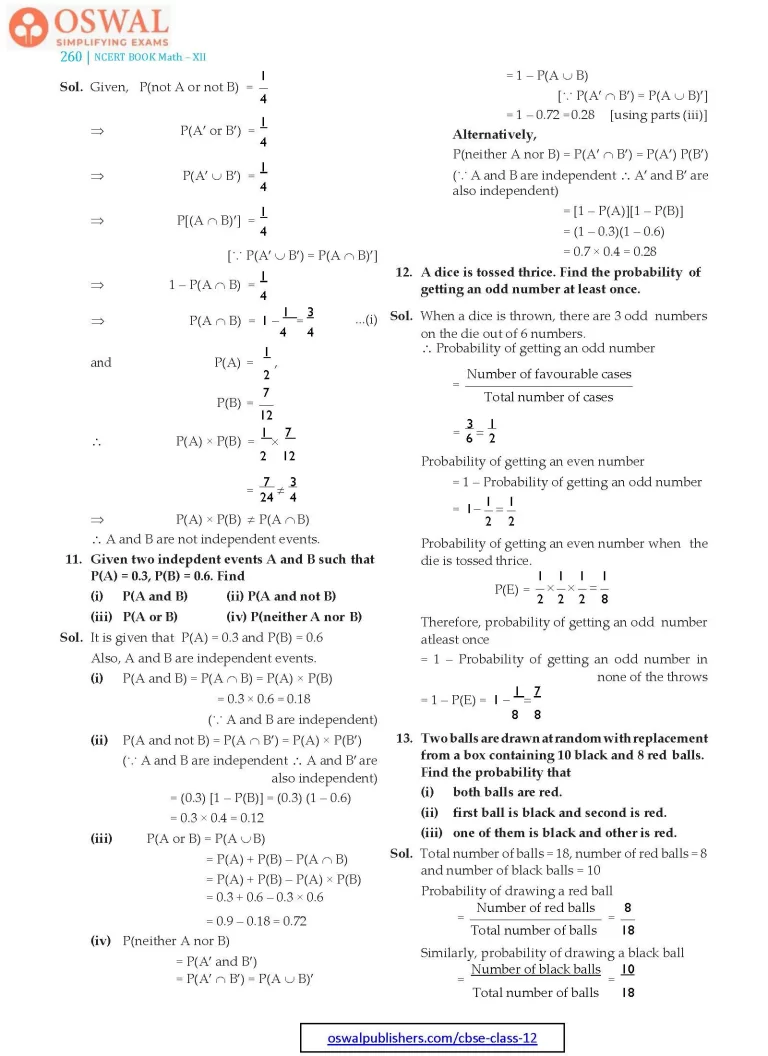
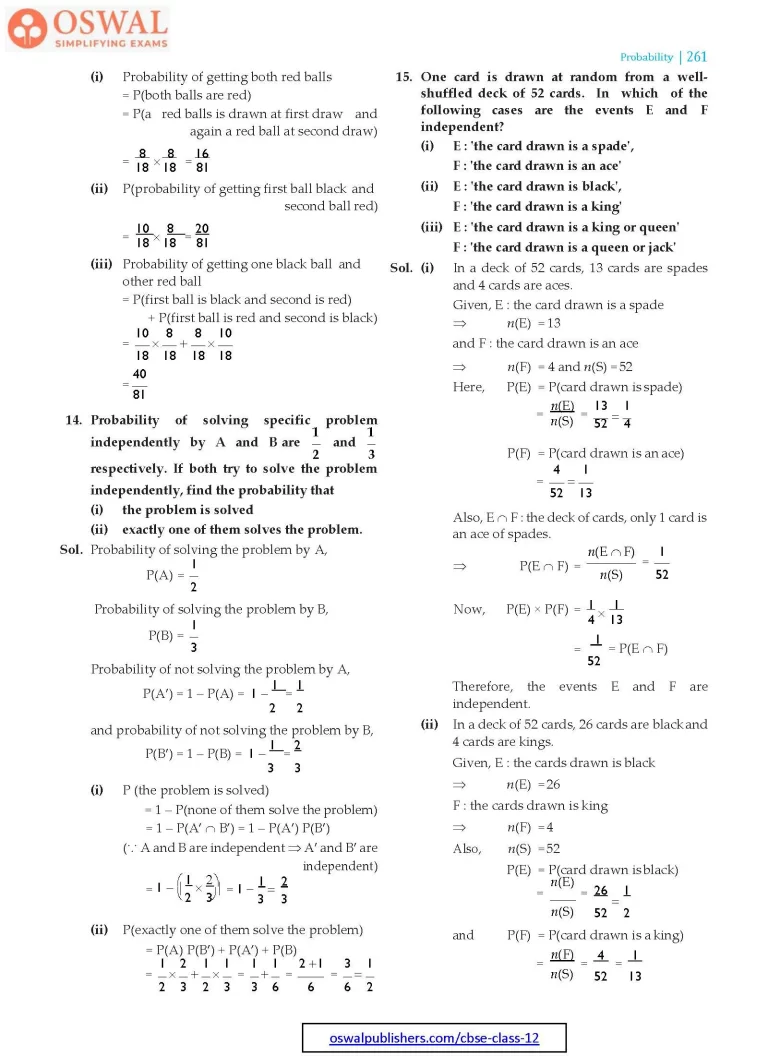
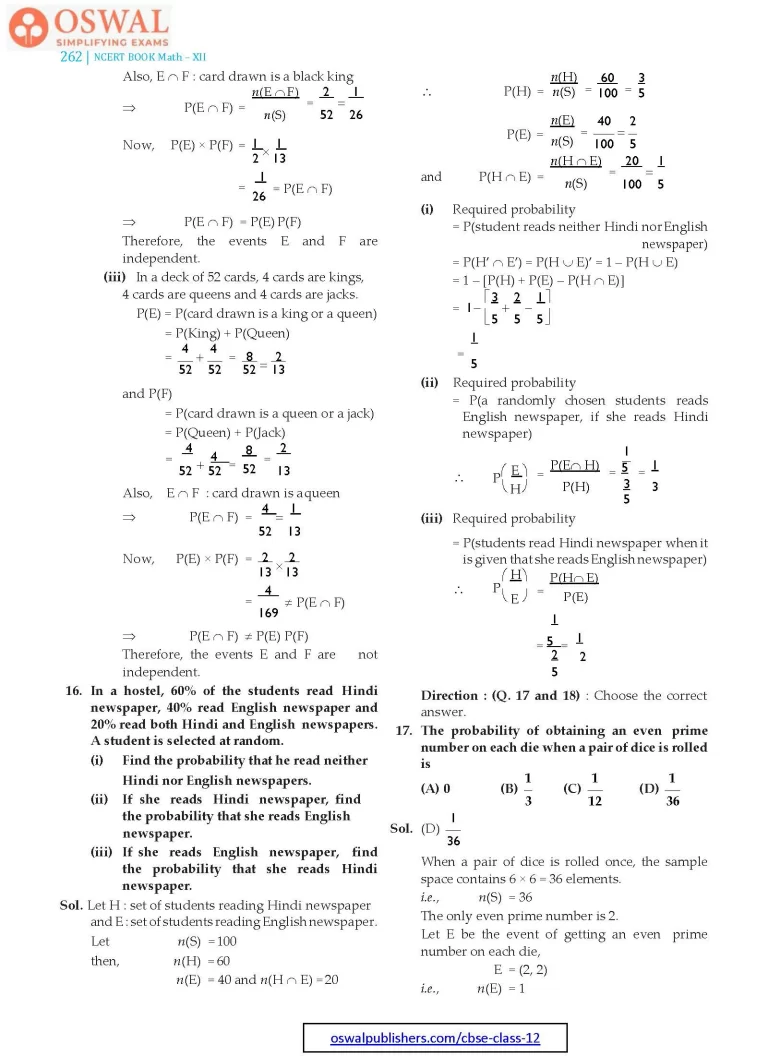
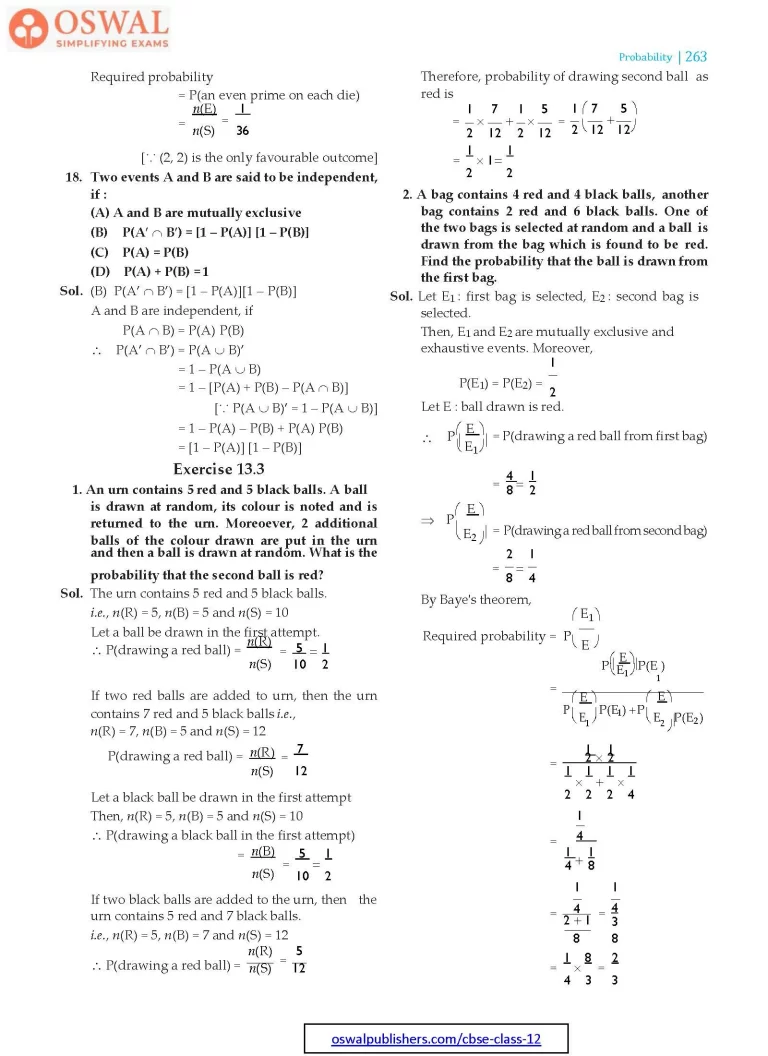
Access Exercises of Class 12 Maths Chapter 13 – Probability
Exercise 13.1 Solutions 17 Questions
Exercise 13.2 Solutions 18 Questions
Exercise 13.3 Solutions 14 Questions
Exercise 13.4 Solutions 17 Questions
Exercise 13.5 Solutions 15 Questions
Miscellaneous Exercise on Chapter 13 Solutions 10 Questions
Exercise 13.2
$$\textbf{1. If P(A) =}\frac{\textbf{3}}{\textbf{5}}\space\textbf{and P(B) =}\frac{\textbf{1}}{\textbf{5}}\textbf{,}\\\textbf{then P(A ∩ B), if A and B}\\\textbf{are independent events.}\\\textbf{Sol.}\space \text{It is given that P(A) =}\frac{3}{5}\\\text{and}\space\text{P(B)} = \frac{1}{5}$$
As, A and B are independent events, therefore
P(A ∩ B) = {P(A) × P(B)}
$$ =\frac{3}{5}×\frac{1}{5} =\frac{3}{25}.$$
2. Two cards are drawn at random without replacement from a pack of 52 playing cards. Find the probability that both the cards are black.
Sol. There are 26 black cards in a pack of 52 cards.
Required probability = P(E and F) = P(E) P(F)
where, E : first card drawn is black,
F : second card drawn is black
$$\text{P(E)} =\\ \frac{\text{Total number of favourable outcomes}}{\text{Total number of outcomess}}\\=\frac{26}{52} = \frac{1}{2}\\\text{P(F)} =\frac{25}{21}$$
(After drawing one black card, there will be 25 black cards)
∴ Required probability
P(E ∩ F) = P(E) P(F)
$$ =\frac{1}{2}×\frac{25}{51} = \frac{25}{102}$$
3. A box of oranges is inspected by examining three randomly selected oranges drawn without replacement. If all the three oranges are good, the box is approved for sale, otherwise, it is rejected. Find the probability that a box containing 15 oranges out of which 12 are good and 3 are bad ones will be approved for sale.
Sol. Let A, B and C be the respective events that the first, second and third drawn orange is good.
Therefore, probability that first drawn orange is good,
$$\text{P(A)} = \frac{12}{15}$$
Therefore, probability of getting second good orange is :
$$\text{P(B)} = \frac{11}{14}$$
(∵ The oranges are not replaced so number of good oranges left is 11)
Similarly, probability of getting third good orange is :
$$\text{P(C)} = \frac{10}{13}$$
(∵ The oranges are not replaced so number of good oranges left is 10.)
The box is approved for sale, if all the three oranges are good.
Thus, the probability of getting all the three good oranges
$$=\frac{12}{15}×\frac{11}{14}×\frac{10}{13}\\\text{Therefore, the probability that}\\\text{the box is approved for sale =}\frac{44}{91}.$$
4. A fair coin and an unbiased die are tossed. Let A be the event 'head appears on the coin' and B be the event '3 on the die'. Check whether A and B are independent events or not.
Sol. It a fair coin and an unbiased die are tossed, then the sample space S is given by,
$$\text{S =}\begin{Bmatrix}(\text{H},1),(\text{H},2),(\text{H},3),(\text{H},4),\\(\text{H},5),(\text{H},6)\\(\text{T},1),(\text{T},2),(\text{T},3),(\text{T},4),\\(\text{T},5),(\text{T},6)\end{Bmatrix}\\\Rarr\space n(S) = 12$$
Also, A : head appears on the coin
B : 3 appears on the die.
∴ A = set of events having head on one coin
= {(H, 1), (H, 2), (H, 3), (H, 4), (H, 5), (H, 6)},
B = set of events having 3 on one die
= {(H, 3), (T, 3)}
⇒ A ∩ B = {(H, 3)}
⇒ n(A) = 6
n(B) = 2
n(A ∩ B) = 1
$$\text{Hence,}\space\text{P(A)} =\frac{6}{12} =\frac{1}{12}\\\text{P(B)} =\frac{2}{12} = \frac{1}{6}\\\text{and}\space\text{P(A}\cap \text{B}) =\frac{1}{12}\\\text{Now, P(A)×P(B)}\\=\frac{1}{2}×\frac{1}{6}= \frac{1}{12}$$
= P(A ∩ B)
Therefore, A and B are independent events.
5. A die marked 1, 2, 3 in red and 4, 5, 6 in green is tossed. Let A be the event, 'the number is even' and B be the event, 'the number is red'. Are A and B independent?
Sol. When a die is thrown, the sample space
S = {1, 2, 3, 4, 5, 6}.
Also, A : number is even and B : number is red
∴ A = {2, 4, 6} and B = {1, 2, 3} and A ∩ B = {2}.
⇒ n(A) = 3, n(B) = 3, n(A ∩ B) = 1
$$\text{Now,}\space\text{P(A)} =\frac{3}{6} =\frac{1}{2}\\\text{P(B)} =\frac{3}{6} =\frac{1}{2}\\\text{P(A}\cap \text{B}) = \frac{1}{6}\\\text{and}\space \text{P(A)×P(B)}\\=\frac{1}{2}×\frac{1}{2}\\=\frac{1}{4}\neq\frac{1}{6} = \text{P(A}\cap \text{B})\\\Rarr\space\text{P(A}\cap \text{B}) \neq\text{P(A)}\text{P(B)}$$
Thus, A and B are not independent events.
$$\textbf{6. Let E and F be events with}\\\textbf{P(E) =}\frac{\textbf{3}}{\textbf{5}},\textbf{P(F)} \textbf{=} \frac{\textbf{3}}{\textbf{10}}\\\textbf{and}\space \textbf{P(E}\cap\textbf{F})\textbf{=}\frac{\textbf{1}}{\textbf{5}}\textbf{.}\space\\\textbf{Are E and F independent?}\\\textbf{Sol.\space}\text{It is given that P(E) =}\frac{3}{5},\\\text{P(F)} = \frac{3}{10}\space\text{and}\space\text{P(E}\cap \text{F)}=\frac{1}{5}\\\text{Now,}\space\text{P(E)}.\text{P(E)} = \frac{3}{5}×\frac{3}{10} = \\\frac{9}{50}\neq\frac{1}{5} =\text{P}(\text{E}\cap\text{F})$$
Therefore, E and F are not independent events.
7. Given that the events A and B are such that
$$\textbf{P(A)} \textbf{=} \frac{\textbf{1}}{\textbf{2}},\textbf{P(A}\cup \textbf{B)} \textbf{=}\frac{\textbf{3}}{\textbf{5}}\space\\\textbf{and\space}\textbf{P(B)} \textbf{= p}.\space\textbf{Find p,}\\\textbf{if they are}\\\textbf{(i) mutually exclusive} \\\textbf{(ii) independent}$$
Sol. (i) When A and B are mutually exclusive, then
A ∩ B = Φ
⇒ P(A ∩ B) = 0
∴ P(A ∪ B) = P(A) + P(B) – P(A ∩ B)
$$\Rarr\space \frac{3}{5} =\frac{1}{2} + p-0\\\Rarr \space \text{p} = \frac{3}{5} - \frac{1}{2}\\=\frac{6-5}{10} = \frac{1}{10}$$
(ii) When A and B are independent events, then
$$\text{P(A}\cap \text{B}) = \text{P(A)}.\text{P(B)} \\=\frac{1}{2}p\\\bigg(\because\text{P(A) =} \frac{1}{2},\text{P(B)} =p\space\text{(given)}\bigg)$$
Now, P(A ∪ B) = P(A) + P(B) – P(A) × P(B)
$$\Rarr\space\frac{3}{5} = \frac{1}{2} + p - \frac{1}{2}p\\\Rarr\space \frac{3}{5} - \frac{1}{2} = \frac{\text{2p-p}}{2}\\\Rarr\space\frac{p}{2} = \frac{6-5}{10}\\\Rarr\space p = \frac{2}{10} = \frac{1}{5}$$
8. Let A and B be independent events with
P(A) = 0.3 and P(B) = 0.4. Find
(i) P(A ∩ B)
(ii) P(A ∪ B)
(iii) P(A/B)
(iv) P(B/A)
Sol. It is given that P(A) = 0.3 and P(B) = 0.4
(i) If A and B are independent events, then
P(A ∩ B) = P(A) × P(B)
= 0.3 × 0.4 = 0.12
(ii) We know that
P(A ∪ B) = P(A) + P(B) – P(A ∩ B)
= P(A) + P(B) – P(A) . P(B)
= 0.3 + 0.4 – 0.3 × 0.4
= 0.7 – 0.12 = 0.58
(iii) We know that,
$$\text{P}\bigg(\frac{\text{A}}{B}\bigg) = \frac{\text{P}(A\cap B)}{\text{P(B)}} \\=\frac{\text{P(A)}\text{P(B)}}{\text{P(B)}}\\\Rarr\space \text{P}\bigg(\frac{A}{B}\bigg) =\frac{0.12}{0.4} =0.3$$
(iv) We know that,
$$\text{P}\bigg(\frac{B}{A}\bigg) = \frac{\text{P}(\text{B}\cap A)}{\text{P(A)}}\\=\frac{\text{P}(\text{B})\text{P}\text{(A)}}{\text{P(A)}}\\\Rarr\space\text{P}\bigg(\frac{B}{A}\bigg) = \frac{0.12}{0.3}\\=0.4$$
9. If A and B are two events such that
$$\textbf{P(A)} =\frac{\textbf{1}}{\textbf{4}}\textbf{,}\space\textbf{P(B)} \textbf{=}\frac{\textbf{1}}{\textbf{2}}\\\textbf{and\space}\textbf{P}(\textbf{A}\cap\textbf{B}) \textbf{=}\frac{\textbf{1}}{\textbf{8}}\textbf{,}\\\textbf{find P(not A and not B).}\\\textbf{Sol.\space}\text{we have,}\space\text{P(A)} =\frac{1}{4}\\\text{P(B)} = \frac{1}{2}\\\text{P(A}\cap \text{B}) =\frac{1}{8}\\\Rarr\space\text{P(A')} = 1 -\text{P(A)}\\=1-\frac{1}{4} =\frac{3}{4}$$
and P(B′) = 1 – P(B)
$$= 1 - \frac{1}{2} =\frac{1}{2} \\\text{As,\space} \text{P(A}\cap \text{B) =} \frac{1}{8}\\=\frac{1}{4}×\frac{1}{2} $$
= P(A) × P(B).
Therefore, A and B are independent events.
⇒ A′ and B′ are also independent events
∴ P(not A and not B) = P(A′ ∩ B′)
$$ = \text{P(A}')\text{P(B}') =\\\frac{3}{4}×\frac{1}{2}=\frac{3}{8}$$
Note : If A and B are independent events, then A′, B; A, B′ and A′, B′ are also independent events.
$$\textbf{10. Events A and B are such that}\\\textbf{P(A)}= \frac{\textbf{1}}{\textbf{2}}\textbf{,}\space\textbf{P(B)} = \frac{\textbf{7}}{\textbf{12}}\\\textbf{and P(not A or not B)} \textbf{=}\frac{\textbf{1}}{\textbf{4}}\textbf{.}$$
State whether A and B are independent ?
$$\text{Sol.\space}\text{Given, P(not A or not B)} \\=\frac{1}{4}\\\Rarr\space\text{P(A' or B')} =\frac{1}{4}\\\Rarr\space\text{P(A'}\cup \text{B}') =\frac{1}{4}\\\Rarr\space\lbrack \because\space\text{P}(\text{A}'\cap \text{B}') = \text{P}(A\cap B)'\rbrack\\\Rarr\space 1-\text{P}(A\cap B) = \frac{1}{4}\\\Rarr\space \text{P}(\text{A}\cap \text{B}) =\\ 1-\frac{1}{4} =\frac{3}{4}\space\text{...(i)}\\\text{and}\space \text{P(A)} = \frac{1}{2},\\\text{P(B)} =\frac{7}{12}$$
$$\therefore\space \text{P(A)}×\text{P(B)}=\\\frac{1}{2}×\frac{7}{12}\\=\frac{7}{24}\neq\frac{3}{4}\\\Rarr\space \text{P(A)}×\text{P(B)}\neq\text{P(A}\cap B)$$
∴ A and B are not independent events.
11. Given two indepdent events A and B such that P(A) = 0.3, P(B) = 0.6. Find
(i) P(A and B)
(ii) P(A and not B)
(iii) P(A or B)
(iv) P(neither A nor B)
Sol. It is given that P(A) = 0.3 and P(B) = 0.6
Also, A and B are independent events.
(i) P(A and B) = P(A ∩ B) = P(A) × P(B)
= 0.3 × 0.6 = 0.18
(∵ A and B are independent)
(ii) P(A and not B) = P(A ∩ B′) = P(A) × P(B′)
= 1 – P(A ∪ B)
[∵ P(A′ ∩ B′) = P(A ∪ B)′]
= 1 – 0.72 = 0.28 [using parts (iii)]
Alternatively, P(neither A nor B) = P(A′ ∩ B′) = P(A′) P(B′)
(∵ A and B are independent \ A′ and B′ are also independent)
= [1 – P(A)][1 – P(B)]
= (1 – 0.3)(1 – 0.6)
= 0.7 × 0.4 = 0.28
(∵ A and B are independent \ A and B′ are also independent)
= (0.3) [1 – P(B)] = (0.3) (1 – 0.6)
= 0.3 × 0.4 = 0.12
(iii) P(A or B) = P(A ∪ B)
= P(A) + P(B) – P(A ∩ B)
= P(A) + P(B) – P(A) × P(B)
= 0.3 + 0.6 – 0.3 × 0.6
= 0.9 – 0.18 = 0.72
(iv) P(neither A nor B)
= P(A′ and B′)
= P(A′ ∩ B′) = P(A ∪ B)′
= 1 – P(A ∪ B)
[∵ P(A′ ∩ B′) = P(A ∪ B)′]
= 1 – 0.72 = 0.28 [using parts (iii)]
Alternatively,
P(neither A nor B) = P(A′ ∩ B′) = P(A′) P(B′)
(∵ A and B are independent \ A′ and B′ are also independent)
= [1 – P(A)][1 – P(B)]
= (1 – 0.3)(1 – 0.6)
= 0.7 × 0.4 = 0.28
12. A dice is tossed thrice. Find the probability of getting an odd number at least once.
Sol. When a dice is thrown, there are 3 odd numbers on the die out of 6 numbers.
∴ Probability of getting an odd number
$$ = \frac{\text{Number of favourable cases}}{\text{Total number of cases}}\\=\frac{3}{6} =\frac{1}{2}$$
Probability of getting an even number
= 1 – Probability of getting an odd number
$$= 1 - \frac{1}{2} = \frac{1}{2}$$
Probability of getting an even number when the die is tossed thrice.
$$\text{P(E)} = \frac{1}{2}×\frac{1}{2}×\frac{1}{2}\\=\frac{1}{8}$$
Therefore, probability of getting an odd number atleast once
= 1 – Probability of getting an odd number in none of the throws
$$ = 1 - \text{P(E)} =\\ 1 - \frac{1}{8} = \frac{7}{8}$$
13. Two balls are drawn at random with replacement from a box containing 10 black and 8 red balls. Find the probability that
(i) both balls are red.
(ii) first ball is black and second is red.
(iii) one of them is black and other is red.
Sol. Total number of balls = 18, number of red balls = 8 and number of black balls = 10
Probability of drawing a red ball
$$ = \frac{\text{Number of red balls}}{\text{Total number of balls}} \\=\frac{8}{18}$$
Similarly, probability of drawing a black ball
$$ = \frac{\text{Number of black balls}}{\text{Total number of balls}} \\=\frac{10}{18}$$
(i) Probability of getting both red balls
= P(both balls are red)
= P(a red balls is drawn at first draw and again a red ball at second draw)
$$ =\frac{8}{18}×\frac{8}{18} =\frac{16}{81}$$
(ii) P(probability of getting first ball black and second ball red)
$$ = \frac{10}{18}×\frac{8}{18} =\frac{20}{81}$$
(iii) Probability of getting one black ball and other red ball
= P(first ball is black and second is red) + P(first ball is red and second is black)
$$= \frac{10}{18}×\frac{8}{18} + \frac{8}{18}×\frac{10}{18}\\= \frac{40}{81}$$
14. Probability of solving specific problem independently by A and B are
$$\frac{\textbf{1}}{\textbf{2}}\space\textbf{and}\space\frac{\textbf{1}}{\textbf{3}}$$ respectively. If both try to solve the problem independently, find the probability that
(i) the problem is solved
(ii) exactly one of them solves the problem.
Sol. Probability of solving the problem by A,
$$\text{P(A)} = \frac{1}{2}$$
Probability of solving the problem by B,
$$\text{P(B)} = \frac{1}{3}$$
Probability of not solving the problem by A,
$$\text{P(A')} = 1-\text{P(A)}\\= 1 - \frac{1}{2} =\frac{1}{2} $$
and probability of not solving the problem by B,
$$\text{P(B')} = 1 -\text{P(B)}\\ 1 - \frac{1}{3} = \frac{2}{3}$$
(i) P (the problem is solved)
= 1 – P(none of them solve the problem)
= 1 – P(A′ ∩ B′) = 1 – P(A′) P(B′)
(∵ A and B are independent ⇒ A′ and B′ are independent)
$$ = 1-\bigg(\frac{1}{2}×\frac{2}{3}\bigg)\\= 1 - \frac{1}{3} = \frac{2}{3}$$
(ii) P(exactly one of them solve the problem)
= P(A) P(B′) + P(A′) + P(B)
$$ = \frac{1}{2}×\frac{2}{3} + \frac{1}{2}×\frac{1}{3} \\=\frac{1}{3} +\frac{1}{6} = \frac{2+1}{6} \\=\frac{3}{6} = \frac{1}{2}$$
15. One card is drawn at random from a
well-shuffled deck of 52 cards. In which of the following cases are the events E and F independent?
(i) E : 'the card drawn is a spade',
F : 'the card drawn is an ace'
(ii) E : 'the card drawn is black',
F : 'the card drawn is a king'
(iii) E : 'the card drawn is a king or queen'
F : 'the card drawn is a queen or jack'
Sol. (i) In a deck of 52 cards, 13 cards are spades and 4 cards are aces.
Given, E : the card drawn is a spade
⇒ n(E) = 13
and F : the card drawn is an ace
⇒ n(F) = 4 and n(S) = 52
Here, P(E) = P(card drawn is spade)
$$ =\frac{n\text{(E)}}{\text{n(S)}} =\frac{13}{52} = \frac{1}{4}$$
P(F) = P(card drawn is an ace)
$$=\frac{4}{52} = \frac{1}{13}$$
Also , E ∩ F : the deck of cards, only 1 card is an ace of spades.
$$\Rarr\space\text{P}(\text{E}\cap\text{F}) = \frac{n(\text{E}\cap\text{F})}{n(S)}\\=\frac{1}{52}\\\text{Now,\space}\text{P(E)×P(F)}\\=\frac{1}{4}×\frac{1}{13}\\=\frac{1}{52} =\text{P(E}\cap \text{F})$$
Therefore, the events E and F are independent.
(ii) In a deck of 52 cards, 26 cards are black and 4 cards are kings.
Given, E : the cards drawn is black
⇒ n(E) = 26
F : the cards drawn is king
⇒ n(F) = 4
Also, n(S) = 52
P(E) = P(card drawn is black)
$$= \frac{n(\text{E})}{m(\text{S})} = \frac{26}{52}\\=\frac{1}{2}$$
and P(F) = P(card drawn is a king)
$$= \frac{n(\text{F})}{n(\text{S})} = \frac{4}{52} = \frac{1}{13}$$
Also, E ∩ F : card drawn is a black king
$$\Rarr\space \text{P}(\text{E}\cap\text{F}) =\frac{n(\text{E}\cap\text{F})}{n(\text{S})}\\=\frac{2}{52} =\frac{1}{26}\\\text{Now,\space}\text{P(E)}×\text{P(F)} \\=\frac{1}{2}×\frac{1}{13}\\=\frac{1}{26} =\text{P(E}\cap \text{F})\\\Rarr\space \text{P}(\text{E}\cap \text{F}) =\text{P(E)}\text{P(F)}$$
Therefore, the events E and F are independent.
(iii) In a deck of 52 cards, 4 cards are kings, 4 cards are queens and 4 cards are jacks.
P(E) = P(card drawn is a king or a queen)
= P(King) + P(Queen)
$$ =\frac{4}{52} + \frac{4}{52} \\=\frac{8}{52} =\frac{2}{13}$$
and P(F)
= P(card drawn is a queen or a jack)
= P(Queen) + P(Jack)
$$ = \frac{4}{52} + \frac{4}{52}\\=\frac{8}{52} = \frac{2}{13}$$
Also, E ∩ F : card drawn is a queen
$$\Rarr\space\text{P}(\text{E}\cap \text{F}) = \frac{4}{52}\\ =\frac{1}{13}\\\text{Now,\space}\text{P(E)}×\text{P(F)}\\= \frac{2}{13}×\frac{2}{13}\\ = \frac{4}{169}\neq\text{P}(\text{E}\cap\text{F})\\\Rarr\space \text{P}(\text{E}\cap\text{F}) \neq \text{P(E)}\text{P(F)}$$
Therefore, the events E and F are not independent.
16. In a hostel, 60% of the students read Hindi newspaper, 40% read English newspaper and 20% read both Hindi and English newspapers. A student is selected at random.
(i) Find the probability that he read neither Hindi nor English newspapers.
(ii) If she reads Hindi newspaper, find the probability that she reads English newspaper.
(iii) If she reads English newspaper, find the probability that she reads Hindi newspaper.
Sol. Let H : set of students reading Hindi newspaper and E : set of students reading English newspaper.
Let n(S) = 100
then, n(H) = 60
n(E) = 40 and n(H ∩ E) = 20
$$\therefore\space\text{P(H)} = \frac{\text{n(H)}}{\text{n(S)}}\\=\frac{60}{100} = \frac{3}{5}\\\text{P(E)} = \frac{\text{n(E)}}{\text{n(S)}}\\=\frac{40}{100} = \frac{2}{5}\\\text{and}\space \text{P(H}\cap\text{E}) = \frac{n(\text{H}\cap\text{E})}{\text{n(S)}}\\=\frac{20}{100} =\frac{1}{5}$$
(i) Required probability
= P(student reads neither Hindi nor English
newspaper)
= P(H′ ∩ E′) = P(H ∪ E)′ = 1 – P(H ∪ E)
= 1 – [P(H) + P(E) – P(H ∩ E)]
$$= 1 - \bigg[\frac{3}{5} + \frac{2}{5} - \frac{1}{5}\bigg]\\=\frac{1}{5}$$
(ii) Required probability
= P(a randomly chosen students reads English newspaper, if she reads Hindi newspaper)
$$\therefore\space\text{P}\bigg(\frac{\text{E}}{\text{F}}\bigg) = \frac{\text{P}(\text{E}\cap\text{H})}{\text{P}(\text{H})}\\=\frac{\frac{1}{5}}{\frac{3}{5}} =\frac{1}{3}$$
(iii) Required probability
= P(students read Hindi newspaper when it is given that she reads English newspaper)
$$\therefore\space\text{P}\bigg(\frac{\text{H}}{\text{E}}\bigg) = \frac{\text{P(H}\cap \text{E})}{\text{P(E)}}\\ = \frac{\frac{1}{5}}{\frac{2}{5}} =\frac{1}{2}$$
Direction : (Q. 17 and 18) : Choose the correct answer.
17. The probability of obtaining an even prime number on each die when a pair of dice is rolled is
(A) 0
$$\textbf{(B)\space}\frac{\textbf{1}}{\textbf{3}}\\\textbf{(C)\space}\frac{\textbf{1}}{\textbf{12}}\\\textbf{(D)\space}\frac{\textbf{1}}{\textbf{36}}\\\textbf{Sol.}\space\text{(D)\space}\frac{1}{36}$$
When a pair of dice is rolled once, the sample space contains 6 × 6 = 36 elements.
i.e., n(S) = 36
The only even prime number is 2.
Let E be the event of getting an even prime number on each die,
E = (2, 2)
i.e., n(E) = 1
Required probability
= P(an even prime on each die)
$$= \frac{\text{n(E)}}{\text{n(S)}} = \frac{1}{36}\\\lbrack\because\space (2,2)\space\text{is the only}\\\text{ favourable outcome}\rbrack $$
18. Two events A and B are said to be independent, if :
(A) A and B are mutually exclusive
(B) P(A′ ∩ B′) = [1 – P(A)] [1 – P(B)]
(C) P(A) = P(B)
(D) P(A) + P(B) = 1
Sol. (B) P(A′ ∩ B′) = [1 – P(A)][1 – P(B)]
A and B are independent, if
P(A ∩ B) = P(A) P(B)
∴ P(A′ ∩ B′) = P(A ∪ B)′
= 1 – P(A ∪ B)
= 1 – [P(A) + P(B) – P(A ∩ B)]
[∵ P(A ∪ B)′ = 1 – P(A ∪ B)]
= 1 – P(A) – P(B) + P(A) P(B)
= [1 – P(A)] [1 – P(B)]
